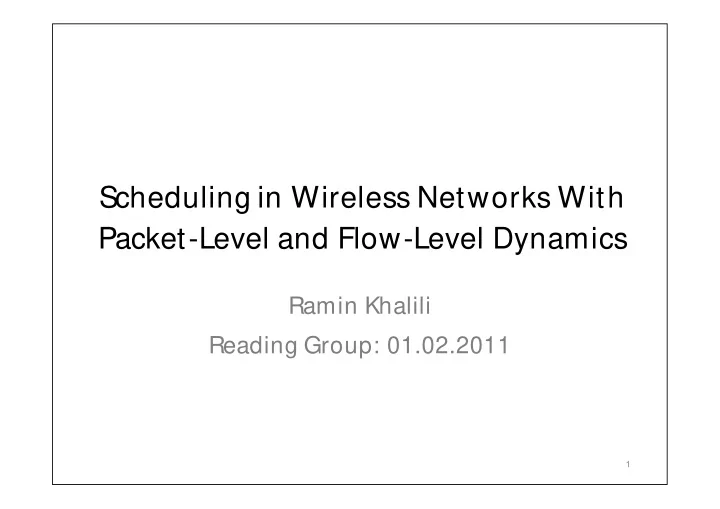

Scheduling in Wireless Networks With Packet-Level and Flow-Level Dynamics Ramin Khalili Reading Group: 01.02.2011 1
Outline • network model • packet-level scheduling • flow-level scheduling • multi-channel case • conclusion 2
Network model • wireless downlink network • single base station . . . . . . with a single channel • multi-user • discrete-time • goal: optimal allocation of available resource at BS (time) to users 3
Outline • network model • packet-level scheduling • flow-level scheduling • multi-channel case • conclusion 4
Static user population • Fix set of users ( N ) λ 1 λ i λ N • a queue per each user . . . . . . 1 i N • input with average rates ( λ 1 ,… , λ N ) in bits/se c • stability: queue . . . . . . length process does not blow to infinity N 1 i 5
Channel model • time-varying channel: – c(t) : channel state at time t . . . . . . – C : set of channel states R i,c(t) – π c : average probability for state c ∈ C • R i,c(t) : rate of user i if served at t by BS – depend on i ’s position and c(t) 6
Queue lengths • Φ i (t) : queue length of user i at time t Φ i (t+ 1)= Φ i (t)-D i (t)+ A i (t) • A i (t) : number of arrived bits • D i (t)= min{ Φ i (t),R i,c(t) } if i is served, 0 o.w 7
Stability analysis • capacity region: set of all input rates ( λ 1 ,… , λ N ) such that there exist φ i,c ≥0 , ∑ i= 1:N φ i,c = 1 for all c , such that λ i < Σ c π c φ i,c R i,c 8
Stabilizing algorithm • M axWeight scheduling: at time t schedule queue i such that i ∈ arg max j R j,c(t) Φ j (t) • different versions of proof: Lyapunov drift, fluid limit technique 9
It is to note that … . • M axWeight scheduling: – needs to know current channel state c(t) – but no a priori information about π c and ( λ 1 ,… , λ N ) • knowing π c and ( λ 1 ,… , λ N ) cannot help to achieve better performance than M axWeight 10
Outline • network model • packet-level scheduling • flow-level scheduling • multi-channel case • conclusion 11
Dynamic user population • number of users varies in time: – users arrive at different times – have finite numbers of bits to transmit – leave after their bits are transmitted • flow refers to this finite size sessions • stability condition: number of unserved users remain finite 12
A network with K (finite and fix) distinct classes • A user class defined by a pair of random variables (R,F) • R ki (t) : rate of i -th class- k user if served at t – R ki (t), R ki (t+ 1), … are i.i.d copies of random variable R k max = sup{x:Pr(R k = x)> 0} – R k • F ki : traffic in bits generated by class- k user i – F k1 , F k2 , … are i.i.d copies of random variable F k with mean E{F k } 13
Stability analysis • λ k (flows/sec): class- k users arrival rate – arrivals are i.i.d across time and classes • capacity region: set of all user (flow) arrival rates ( λ 1 ,… , λ K ) such that ρ = ∑ k= 1:K λ k E{ ⎡ F k /R k max ⎤ } ≤ 1 14
Stabilizing algorithm • workload-based scheduling – (i): serve class- k user i at time t if max (ties broken arbitrary) R ki (t)= R k – (ii): randomly schedule a user if no user satisfies (i) • key idea: reduce workload by one at each time step 15
It is to note that … . max • workload-based needs to know R k and λ k for any k • workload-based scheduling with learning: – a purely opportunistic algorithm – a user transmits if it sees its best channel state so far – BS needs only to know c(t) 16
Related work • Borst 03 & 05, Borst-Bonald-Proutier 04 & 09 • Flow-level dynamics, but use time scale separation assumption – file sizes are large, so users see time average throughput region which is fixed or changes slowly • Shneer 09, Srinkant 09 & 10 (presented in this talk) does not use such an assumption 17
Outline • network model • packet-level scheduling • flow-level scheduling • multi-channel case • conclusion 18
M ultiuser multichannel wireless downlink • so far consider single channel scenario • what if we have M (frequency) channels • Ex: L TE A network with 3 users and 2 channels A network with 3 users and 2 channels 19
Packet-level throughput optimal algorithm • M axWeight scheduling is optimal – serve user i over channel j at time t if i ∈ arg max q R q,j,c(t) Φ q (t) – R q,j,c(t) is rate of user i if served at t over channel j • c µ-rule scheduler stabilizes network – M axWeight is an specific case 20
Flow-level throughput optimal algorithm • channel-assignment: determine number of times a user will transmit over a channel • workload-based scheduling: schedule user i over channel j if it can send with its maximum rate – keeping in mind channel-assignment’s decision 21
Conclusion • packet-level: static population of users • flow-level: dynamic population of users (number of users could growth to infinity) • which one is more realistic? • packet-level and flow-level studies result different stability regions 22
Recommend
More recommend